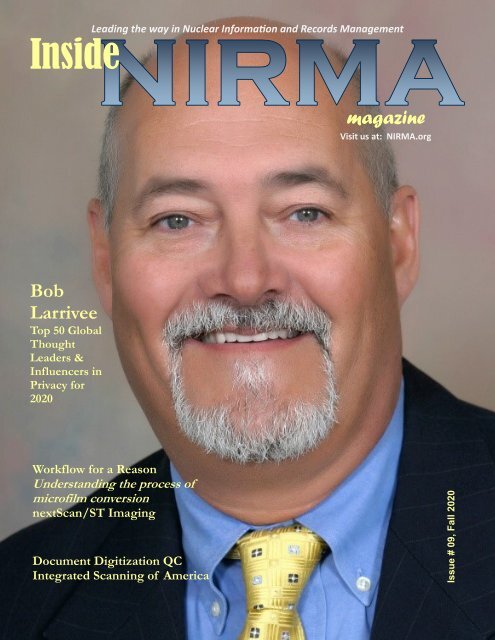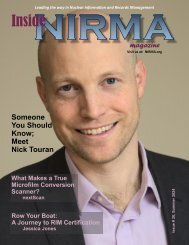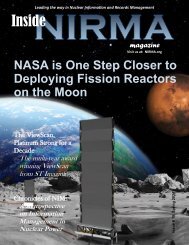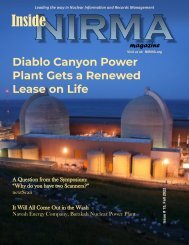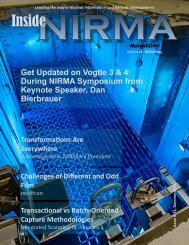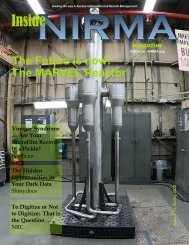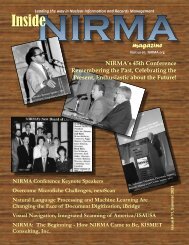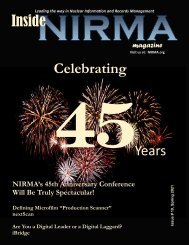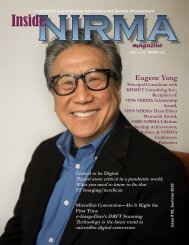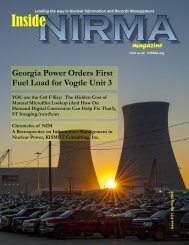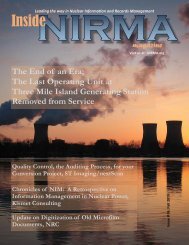Inside NIRMA Fall 2020
You also want an ePaper? Increase the reach of your titles
YUMPU automatically turns print PDFs into web optimized ePapers that Google loves.
<strong>Inside</strong><br />
Leading the way in Nuclear Information and Records Management<br />
magazine<br />
Visit us at: <strong>NIRMA</strong>.org<br />
Bob<br />
Larrivee<br />
Top 50 Global<br />
Thought<br />
Leaders &<br />
Influencers in<br />
Privacy for<br />
<strong>2020</strong><br />
Workflow for a Reason<br />
Understanding the process of<br />
microfilm conversion<br />
nextScan/ST Imaging<br />
Document Digitization QC<br />
Integrated Scanning of America<br />
Issue # 09, <strong>Fall</strong> <strong>2020</strong>
Contents<br />
<strong>Fall</strong> <strong>2020</strong><br />
5<br />
7<br />
11<br />
Workflow for a Reason<br />
Understanding the process of microfilm conversion<br />
By Matt Anderson, Vice President of Marketing, ST Imaging / nextScan<br />
Bob Larrivee Selected as one of the “Top 50 Global Thought<br />
Leaders & Influencers on Privacy” for <strong>2020</strong><br />
Document Digitization QC<br />
By Manuel Bulwa, Integrated Scanning of America<br />
8<br />
12<br />
13<br />
From the CRM: So You Want to Become a CRA/CRM?<br />
By Gil Brueckner, CRM/NS<br />
From the Institute for Certified Records Managers (ICRM) Office<br />
Information Capture: Looking Beyond Records<br />
By Bob Larrivee, President of Bob Larrivee Consultancy<br />
14<br />
16<br />
Chronicles of NIM: A Retrospective on Information Management in<br />
Nuclear Power<br />
By Eugene Yang, KISMET Consulting, Inc.<br />
<strong>2020</strong> <strong>NIRMA</strong> Conference Pictorial<br />
2 <strong>Fall</strong> <strong>2020</strong> <strong>NIRMA</strong>.org <strong>Inside</strong> <strong>NIRMA</strong>
<strong>Fall</strong> <strong>2020</strong><br />
CONTENTS<br />
in every issue<br />
TREASURER REPORT—6<br />
FROM THE PRESIDENT—20<br />
VICE PRESIDENT REPORT—21<br />
PDBU NEWS—21<br />
M&MBU NEWS—22<br />
RIMBU NEWS—23<br />
INDUSTRY NEWS—24<br />
Editors<br />
Neal and Sandra Miller<br />
DevereauxInc@outlook.com<br />
Advertising<br />
Neal.F.Miller@gmail.com<br />
<strong>NIRMA</strong> Headquarters<br />
Sarah Perkins<br />
<strong>NIRMA</strong> Administrator<br />
245 Sunnyridge Ave., #41<br />
Fairfield, CT 06824<br />
nirma@nirma.org<br />
In addition to our own articles,<br />
<strong>Inside</strong> <strong>NIRMA</strong> publishes guest<br />
articles from agencies and<br />
vendors. Please be advised that<br />
the views and opinions<br />
expressed in these articles are<br />
those of the authors and do not<br />
necessarily reflect the opinions<br />
of <strong>NIRMA</strong> or its Board of<br />
Directors.<br />
<strong>Inside</strong> <strong>NIRMA</strong> <strong>NIRMA</strong>.org <strong>Fall</strong> <strong>2020</strong> 3
Workflow<br />
for a Reason<br />
Understanding the process of<br />
microfilm conversion.<br />
By Matt Anderson,<br />
Vice President of Marketing, nextScan<br />
W<br />
hile you may think microformcapture<br />
is simple: Point,<br />
Shoot, and Capture; TRUE<br />
microform conversion is<br />
complicated. The engineers at nextScan<br />
have decades of combined experience<br />
scanning microforms. Over those years<br />
they have learned to streamline and<br />
perfect the conversion process rather<br />
than cut corners, literally.<br />
First, all data must be captured and<br />
frames must be detected instantly.<br />
When we capture a roll of film we save<br />
it as RAW data allowing for maximum<br />
flexibility during the remaining<br />
operations. Next, a technician audits the<br />
scan to make sure all data has been<br />
Every conversion project is<br />
important, vital even. Your<br />
records are important to us<br />
too. This is why we created a<br />
process that not only scans<br />
your microfilm quickly, but<br />
also delivers perfect images<br />
with all being captured with<br />
complete confidence.<br />
collected properly,<br />
and then makes<br />
any necessary<br />
adjustments before<br />
indexing. And<br />
finally, we create a datafile to deliver a<br />
document when requested. So, why do<br />
we do it this way? When scanning<br />
thousands, or even millions of<br />
microfilm images, you cannot afford to<br />
miss a single one.<br />
One Size Does Not Fit All<br />
nextScan, along with ST Imaging,<br />
make up the microfilm division of<br />
Digital Check, the<br />
world’s leading<br />
manufacturer of<br />
check scanners. Not<br />
only are we experts<br />
in the field of<br />
microform capture<br />
but also check and<br />
other imaging. We<br />
offer many<br />
technologies with<br />
our scanning<br />
solutions, including<br />
Contact Image<br />
Sensors (CIS), Area<br />
Array Cameras, and<br />
Line Scan Sensors.<br />
We use CIS sensors<br />
in our check<br />
scanning products. We offer an Area<br />
Array Camera, which is like the camera<br />
in your cell phone, in our ViewScan 4<br />
microfilm scanner. And we use a Line<br />
Scan Sensor on our high-speed capture<br />
scanners. One image sensor is not the<br />
best solution for all situations. Make<br />
sure you use the right tool for your job.<br />
Advantages of Line<br />
Scanning Technology<br />
For continuous, uninterrupted<br />
scanning of microforms, line scanning<br />
technology is superior. Line scanning<br />
involves precise strobe lighting to allow<br />
the line image sensor to capture every<br />
row of pixels, one at a time, as the film<br />
passes below. This ensures nothing is<br />
missed during the capture process.<br />
And a RAW data file is best for<br />
capturing when using a line scan sensor<br />
because it stores every piece of data as<br />
the microfilm moves beneath the<br />
Continued on next page.<br />
Back to Content | <strong>Inside</strong> <strong>NIRMA</strong> <strong>NIRMA</strong>.org <strong>Fall</strong> <strong>2020</strong> 5
STimaging<br />
Continued from previous page.<br />
next can<br />
S<br />
sensor. This RAW data can then be<br />
scrutinized, and any necessary<br />
adjustments can be applied before<br />
output. We all know microfilm<br />
documents are FAR from perfect. The<br />
RAW data file allows for further editing,<br />
such as brightness, contrast, straighten,<br />
and cropping before output. Skipping<br />
this step by directly outputting from<br />
capture forces file compression to<br />
maximize disk space which could result<br />
in lost information that could never be<br />
recovered.<br />
Additionally, any number of file<br />
types can be built from the original<br />
RAW data file. This means that PDF,<br />
PDF/A, TIFF, JPEG, BMP, and many<br />
more types can be created providing<br />
maximum flexibility. Other solutions<br />
force users to determine the file type<br />
before conversion, severely limiting the<br />
user’s post-scan options.<br />
Area Array Cameras<br />
The Area Array Camera is a very<br />
good camera for single shot, stabilized<br />
capture. These are similar to the sensors<br />
found in your cell phone or digital<br />
camera. These cameras are ideal for<br />
taking still images and delivering high<br />
resolution images, which is why we use<br />
this style of camera in the ViewScan 4<br />
on-demand microfilm scanner.<br />
However, any movement or vibration of<br />
the camera or microform may cause<br />
distortion to the image which can cause<br />
the image to appear smeared or to<br />
overlap resulting in poor image quality.<br />
You can see an example of this by<br />
taking a picture with your phone while<br />
moving it. That is not the kind of scan<br />
you want permanently in your archive.<br />
Scan with the Conversion<br />
Experts<br />
Every conversion project is<br />
important, vital even. Your records are<br />
important to us too. This is why we<br />
created a process that not only scans<br />
your microfilm quickly, but also delivers<br />
perfect images with all being captured<br />
with complete confidence. Are you<br />
considering a conversion project? Let<br />
our experience help you convert your<br />
collection with confidence!<br />
<strong>NIRMA</strong>’s Financial Holdings<br />
As of: September 17, <strong>2020</strong><br />
Anita S. Beren<br />
<strong>NIRMA</strong> Treasurer<br />
Money Market Account $ 109,919.46<br />
Checking Account $ 19,105.20<br />
Debit Account $ 967.09<br />
6 <strong>Fall</strong> <strong>2020</strong> <strong>NIRMA</strong>.org <strong>Inside</strong> <strong>NIRMA</strong>
Bob Larrivee Selected<br />
as one of the<br />
“Top 50 Global Thought<br />
Leaders & Influencers<br />
on Privacy”<br />
for <strong>2020</strong><br />
their thoughts on various topics, gain exposure to a wideranging<br />
audience, and connect with peers who share similar<br />
interests. Selection for the Top 50 is done using a patented<br />
algorithm that monitors post activities and ranks them<br />
according to the results<br />
“It is a great honor to be included on this list of global<br />
thought leaders,” said Larrivee. “I want to thank all who<br />
supported me in this endeavor.”<br />
Larrivee was also recently elected to the <strong>NIRMA</strong> Board<br />
of Directors where he will serve over the next three years,<br />
beginning in January 2021. Joining <strong>NIRMA</strong> in 2005, Larrivee<br />
immediately began to jump in and work with the <strong>NIRMA</strong><br />
team to provide high quality education focused on process<br />
improvement and automation, and information management.<br />
“I’d like to congratulate Bob on making the Thinkers 360<br />
list,” said <strong>NIRMA</strong> President Michelle Smith. “We are also<br />
very pleased to have him as a member of our board. He will<br />
be a great asset to our organization.”<br />
N<br />
<strong>2020</strong>.<br />
IRMA Board Member-elect and independent<br />
business consultant, Bob Larrivee was recently<br />
named one of the Thinkers 360’s “Top 50 Global<br />
Thought Leaders and Influencers on Privacy” for<br />
Thinkers 360 is an open platform where analysts,<br />
authors, consultants, and more, are able to write and post<br />
Larrivee is a former vice president and chief analyst of<br />
AIIM International where he developed and delivered a<br />
variety of educational courses and worked to make them<br />
available through the <strong>NIRMA</strong> Pre-conference workshop<br />
offerings. Upon his departure from AIIM, he immediately<br />
engaged with and became part of the <strong>NIRMA</strong> Marketing and<br />
Membership Business Unit helping to provide guidance and<br />
direction for future activities, and member enrollment.<br />
Today, Larrivee is working with business organizations as<br />
an independent consultant, helping document and map their<br />
operational processes and practices, and to identify areas of<br />
opportunity to improve and automate their business<br />
processes and practices.<br />
Click here for full list of recipients.<br />
Back to Content | <strong>Inside</strong> <strong>NIRMA</strong> <strong>NIRMA</strong>.org <strong>Fall</strong> <strong>2020</strong> 7
From the CRM<br />
So You Want to<br />
Become a CRA/CRM?<br />
By Gil Brueckner CRM/NS<br />
I<br />
f you read Bruce Walters’ article “To CRM or Not to<br />
CRM?” in the <strong>Fall</strong> 2019 <strong>NIRMA</strong> newsletter and you’re<br />
thinking about becoming a Certified Records Analyst<br />
(CRA) or Certified Records Manager (CRM), or maybe<br />
you’re already working towards certification, then read on.<br />
This article will describe my journey towards certification and<br />
provide some tips and strategies to make your journey easier.<br />
Cost of Certification<br />
The costs associated with certification are shown below:<br />
I decided to become a CRM after attending the <strong>NIRMA</strong><br />
conference in 2014. I realized I had gaps in my knowledge<br />
and certification provided a means to become more<br />
knowledgeable. I completed CRM certification in 2018.<br />
Requirements for CRA/CRM Certification<br />
The requirements to apply for certification are a<br />
combination of education and experience ranging from a high<br />
school diploma plus five years of experience to a bachelor’s<br />
degree with one year of experience. There is a five-year time<br />
limit to achieve certification, which starts when your<br />
application is accepted. See the ICRM site for more<br />
information on applying for certification.<br />
Ways to Save Money<br />
You can save on books by renting them from<br />
Amazon.com. You can also go to the ICRM – Bookstore to<br />
buy/sell books and other prep resources. You can save<br />
money by not taking an exam prep course, but I don’t<br />
recommend it. The course I took was invaluable!<br />
CRA or CRM?<br />
Which certification should you apply for? It depends on<br />
your interests. The CRA is focused on the core aspects of<br />
RM and is geared towards individual contributors. It requires<br />
passing three exams (Parts 2 – 4). The CRM builds upon the<br />
CRA curriculum by adding leadership and technology topics.<br />
It requires passing six exams (Parts 1 – 6). If you’re not sure<br />
where to start, begin with the CRA. Once you achieve your<br />
CRA (within five years), the clock stops on completing your<br />
full CRM certification. You will be required to maintain your<br />
CRA (100 credit hours every five years), but you can work<br />
toward your CRM whenever you see fit.<br />
Funding Certification<br />
To offset the cost of certification, check with your<br />
employer. Some employers will reimburse certifications. If<br />
yours will, great! If not, perhaps your employer has an<br />
employee award program that can be applied towards<br />
certification. Also, don’t forget to apply for the La ARMA<br />
Nostra Certification Reimbursement Program through the<br />
ARMA International Education Foundation. This annual<br />
program offers six recipients a $500 reimbursement grant to<br />
offset the cost of certification.<br />
Time Commitment<br />
The time spent preparing for the exam will vary with<br />
each person. I spent approximately 250 hours over 2 years to<br />
prepare for the exams for Parts 1 - 6.<br />
8 <strong>Fall</strong> <strong>2020</strong> <strong>NIRMA</strong>.org <strong>Inside</strong> <strong>NIRMA</strong>
Study Strategies<br />
Begin preparing for Parts 1 – 5 with<br />
the ICRM Exam Outlines and Sample<br />
Questions. You will need to refer to this<br />
information as you review the<br />
Recommended Reading material. I used<br />
the Exam Outlines to create a list of<br />
questions to answer as I read the books.<br />
I also used the free study app StudyBlue<br />
to study for Parts 1 - 5 (Tip: Search for<br />
existing study notes that other CRMs<br />
have posted).<br />
For Part 6, which is a timed essay<br />
response to two business case studies, I<br />
attended an exam prep course offered<br />
by my local ARMA chapter. The course<br />
provided sample case studies, responses,<br />
writing strategies, and immediate<br />
feedback. It was helpful! I also<br />
conducted my own timed practice tests<br />
using the sample business cases that the<br />
ICRM provides. Practicing under timed<br />
conditions helped me prepare for the<br />
real thing.<br />
Mentors<br />
I didn’t use a mentor, but I wish I<br />
had. I could have reduced my prep time<br />
had I engaged a mentor early on<br />
(especially for Part 6). If you don’t have<br />
a mentor, the ICRM and ARMA<br />
provide mentors, and I’m willing to<br />
serve as a mentor as well.<br />
Exam Day Preparation<br />
Based on guidance from the exam<br />
prep course, I took the exams for Parts<br />
1 – 5 at one sitting. However, you may<br />
want to take the tests one at a time—do<br />
what works best for you. To prepare, I<br />
studied intensely for two weeks prior to<br />
test day. You will want to review the<br />
Online Exam FAQs and “Taking the<br />
Test” video on the ICRM site<br />
(www.icrm.org). The video is important,<br />
as the ICRM has switched to online<br />
testing via Examity and you will want to<br />
familiarize yourself with it.<br />
For the Part 6 exam, I wrote several<br />
practice essays prior to the exam. My<br />
strategy for responding to a business<br />
case was to read the case quickly, then<br />
read it again and take notes, log any<br />
tasks specified in the case, and then<br />
begin writing. It’s important to pay<br />
attention to the instructions in the case<br />
and to use correct grammar and spelling,<br />
as graders can deduct points for poor<br />
grammar and spelling. Monitor your<br />
time during the Part 6 exam. Four hours<br />
to write two essays goes very quickly!<br />
Is Certification<br />
Worth the Effort?<br />
Absolutely! I use the knowledge I’ve<br />
gained every day at work. If you’re on<br />
the path to certification, don’t hesitate<br />
to reach out to me or other CRA/CRMs<br />
for advice. If you haven’t yet begun the<br />
journey towards certification—why not?<br />
It’s worthwhile!
It’s Our Birthday!<br />
For over 15 years, iBridge has helped thousands of<br />
organizations like <strong>NIRMA</strong> with their digital<br />
transformation needs.<br />
In celebration of starting our 16 th year<br />
we are adding new products, services<br />
and a totally new look.<br />
WE LISTEN. WE LEARN.<br />
WE EXECUTE.<br />
The new iBridge “infinity” logo is a symbol of expansion<br />
and an embrace of boundless innovation. The aspect of infinity<br />
is also an embrace of the customer-centric philosophy<br />
that has been at iBridge since inception.<br />
www.ibridgellc.com
DOCUMENT<br />
DIGITIZATION<br />
QC<br />
S<br />
ome industries tolerate<br />
Errors and Omissions (EO’s)<br />
in their document digitization<br />
projects more than others. In<br />
fact, some clients irresponsibly assume,<br />
without properly checking, that their<br />
Digitization Service Provider delivered<br />
all records, all meeting the<br />
requirements. Unfortunately, a late<br />
detection may have devastating, often<br />
irreparable consequences.<br />
Clients should demand solid answers<br />
from their providers about how their<br />
QC methodologies apply to the project,<br />
then trust and verify. Answers may<br />
include:<br />
A. Random sampling: Although<br />
essential in most projects for testing<br />
purposes, random sampling<br />
overpromises and under delivers.<br />
B. 100% QC: an elusive,<br />
underestimated notion often<br />
challenging due to time, cost and<br />
other constraints.<br />
C. Counting pages: Partially useful,<br />
but error prone, unreliable.<br />
D. Weak answers signal trouble. If<br />
clients do not act, egg is on their<br />
face.<br />
This article aspires to illustrate some<br />
better answers, and to lay a foundation<br />
for a production model to prevent,<br />
detect, remediate, reduce, trace and<br />
monitor EOs in a document digitization<br />
project.<br />
The basic concept is to identify<br />
critical points where EOs may occur<br />
and establish preventive and corrective<br />
semi-automated methodologies around<br />
certain metrics. By “semi-automated” I<br />
mean a combination of smart<br />
automation and human oversight. I use<br />
methodologies that enable valuable<br />
checks and balances in four workflow<br />
stages:<br />
1. Origination: At the point of<br />
custody acceptance.<br />
2. Production (Physical Context): At<br />
the beginning or end of each task<br />
throughout the production<br />
workflow.<br />
3. Published (Logical Context): When<br />
pages are classified, indexed and<br />
organized as logical documents.<br />
4. Submittal: When deliverables are<br />
subject to final acceptance.<br />
By cross-referencing, comparing and<br />
analyzing aggregate numbers based on<br />
data represented in these four<br />
coordinate systems, EOs become more<br />
conspicuous, allowing for remediation<br />
processes to be effective.<br />
A simplified production workflow<br />
includes many tasks (*), what could<br />
possibly go wrong?:<br />
<br />
<br />
By Manuel Bulwa,<br />
Integrated Scanning of America<br />
www.isausa.com<br />
Some documents may not have<br />
made it entirely through the<br />
production workflow.<br />
Pages can be missed, mutilated,<br />
folded, obstructed, out of sequence,<br />
out of scale, illegible, wrongly split<br />
or merged, overlapped, files may be<br />
corrupted, …<br />
<br />
<br />
<br />
<br />
<br />
<br />
<br />
Page groups can be wrongly<br />
classified, not indexed, duplicated,<br />
“buried”, …<br />
Incorrect, missing or extraneous<br />
document structures.<br />
Incomplete, missing or “made up”<br />
documents, …<br />
Deliverables may be incomplete,<br />
redundant, not fully complying with<br />
SOW, …<br />
Originals may be returned or<br />
disposed of without a valid digital<br />
counterpart.<br />
Originals may not be returned in<br />
full.<br />
Originals may not be returned as<br />
expected.<br />
Other.<br />
What are the causes of EOs?<br />
Each EO is associated to a root cause<br />
(*).<br />
Who is responsible for<br />
consequences?<br />
Both service provider and client have<br />
separate responsibilities(*).<br />
How can EOs be detected and<br />
corrected?: (*)<br />
<br />
<br />
<br />
Planning, testing and training<br />
Timing<br />
Use production level equipment<br />
Continued on next page.<br />
Back to Content | <strong>Inside</strong> <strong>NIRMA</strong> <strong>NIRMA</strong>.org <strong>Fall</strong> <strong>2020</strong> 11
Continued from previous page.<br />
<br />
<br />
<br />
<br />
<br />
<br />
<br />
Use customizable production level software<br />
Beware of the human factor<br />
Avoid transactional capture, adopt batch capture<br />
methodologies instead<br />
Use ribbon methodologies for microforms<br />
Define and apply metrics for each category of defects<br />
Do not overlook the need to QC the return of originals<br />
100% QC:<br />
True 100% QC calls<br />
for a comparison<br />
between all originals<br />
against their digital<br />
version. My proposed<br />
model includes a<br />
video inventory of all<br />
originals before the<br />
Image blurred to protect client<br />
capture workflow<br />
confidenal data.<br />
starts, using smart<br />
glasses to facilitate “hands free” video recording. The<br />
downloaded video is analyzed by software to produce the<br />
“best” still images captured. We once recorded every<br />
page of every folder for a Human Resources project to<br />
perform 100% page by page visual QC against the<br />
scanned images. The video batches were distributed<br />
across multiple local and remote operators working on<br />
side by side image comparisons with all exceptions<br />
<br />
flagged, audited and acted upon.<br />
From the Institute for<br />
Certified Records<br />
Managers (ICRM) Office<br />
O<br />
n October 1, <strong>2020</strong> the Institute for Certified<br />
Records Managers announced its newest Post<br />
Certification Specialty Designation, the CRM/<br />
CIGO (Certified Information Governance<br />
Officers).<br />
The new CRM/CIGO certification process includes a<br />
training and testing program that is 100% online. The training<br />
is a master class in Information Governance (IG), followed<br />
by a week of study, and the CIGO certification examination.<br />
CRMs may enroll in the program at special rates beginning<br />
October 16, <strong>2020</strong> through June 1, 2021; and pay no<br />
application fee or CIGO membership fee.<br />
Manifest:<br />
A video inventory<br />
may instead capture<br />
only folder labels for<br />
manifest purposes, as<br />
a reliable manifest is<br />
the only way to<br />
initialize useful<br />
metrics. We video inventoried boxes of medical records<br />
at an average of two to three minutes per box. This<br />
manifest may have saved lives and helped in litigation.<br />
Conclusion:<br />
Automation makes possible to audit and trace QC/repair<br />
efforts, while human oversight helps control automation<br />
errors. Either one by itself, without the other is not sufficient.<br />
When smartly applied to relevant metrics using creative<br />
checks and balances, EOs become detectable and repairable.<br />
When smartly applied to batch oriented production workflow<br />
tasks, automation drastically reduces human EOs.<br />
(*): The original article has been substantially cut to comply<br />
with editorial space restrictions. Questions and additional<br />
levels of detail are available by request, emailing the author:<br />
mbulwa@isausa.com. Some of the concepts explained in this<br />
article are illustrated in a 5 minute video (click here to watch).<br />
The CRM/CIGO certification application will be on the<br />
ICRM.org website starting October 16, <strong>2020</strong>. When a CRM<br />
applies for the CRM/CIGO, a discount code will be<br />
provided. Then registration for the training and examination<br />
will occur on the CIGOA.org website. The discount code for<br />
the training and examination will be applied at checkout.<br />
CRM/CIGO certification will follow ICRM rules and<br />
procedures. CRM yearly membership fees are not increased<br />
due to the CIGO certification, however, an additional 20<br />
CMPs in the IG discipline will be required per five year cycle<br />
and will be prorated on an annual basis.<br />
Read the full press release here.<br />
12 <strong>Fall</strong> <strong>2020</strong> <strong>NIRMA</strong>.org <strong>Inside</strong> <strong>NIRMA</strong>
Inform[tion C[ptur_:<br />
Looking B_yon^ R_]or^s<br />
By Bob Larrivee<br />
Bob Larrivee Consultancy<br />
W<br />
e are increasingly hearing about information capture<br />
these days, and the important role it plays in relation<br />
to accessing it from anywhere, at any time, and on<br />
any device. This has never been more true than<br />
current times as businesses are hard pressed to keep their<br />
businesses operational using a remote workforce due to the<br />
COVID-19 outbreak.<br />
When we talk about information capture, there is a<br />
tendency to focus on records, yet records alone do not make<br />
up the entire corpus of vital business information.<br />
Information that comes from many sources and can be<br />
captured in many different ways. Of course, we are all<br />
familiar with using scanners to capture paper-based<br />
information, and there are ways to capture and ingest digitally<br />
born information like documents, spreadsheets, and more,<br />
but what of other types of information?<br />
In the nuclear industry, there is vital information<br />
related to systems, using sensors to track and manage various<br />
plant components and operational elements. Information is<br />
generated by drones, digital cameras, and humans using<br />
mobile devices like smartphones and tablets. So, information<br />
capture must now take a turn to go beyond just records to<br />
encompass a broader scope of information and ways to<br />
capture, manage, store, preserve, and share it.<br />
Information or Data or Record<br />
Over the years, I have heard and continue to hear discussions<br />
about data, data driven environments yet when you ask what<br />
data means, the response will vary greatly from person to<br />
person, based on their role within an organization. If you<br />
consider the definition that data are facts and statistics<br />
collected together for reference or analysis, one might<br />
conclude that proper context is provided in order to<br />
understand the data. It has always been my position that 42 is<br />
a data element, but without context, it is meaningless. When<br />
placed in proper context - $42.00 for a shirt – we now<br />
understand what 42 represents. This in turn makes it<br />
information containing data that is<br />
now meaningful.<br />
Once this information is<br />
ingested, analyzed, and acted upon, it<br />
might be saved and properly managed<br />
for future use, and yes, it may also be considered a record in<br />
which case it would be managed under the information<br />
governance guidelines addressing records management<br />
practices. My point here being that as curators of information<br />
and records, you must consider all possibilities of<br />
information capture, not just records.<br />
In My View<br />
The nuclear industry is unique in the sense that<br />
information and records are generated from many sources.<br />
Based on where you are employed, this information could be<br />
focused and soured within a power station, nuclear powered<br />
vessel, storage or containment facility, or logistics company.<br />
Vital information crosses departments ranging from plant<br />
operations, to human resources where employee medical<br />
records and x-rays may be found, documenting exposure<br />
levels.<br />
The devices used to capture this information might<br />
include scanners, digital business applications, robots, drones,<br />
geolocational tracking transmitters, and handheld devices.<br />
The locations of these information sources could be static as<br />
in a physical plant, or dynamic as in transport or nuclear<br />
powered vessels. In the near future, we will be capturing data<br />
from other planets as space exploration excels and the use of<br />
mini reactors increases.<br />
The time is now to look beyond records, assess what<br />
information is out there, how it is created, where it is sourced<br />
from, and what is needed to manage it securely and properly.<br />
Information and records should be viewed equally when it<br />
comes to capture not as separate entities.<br />
Back to Content | <strong>Inside</strong> <strong>NIRMA</strong> <strong>NIRMA</strong>.org <strong>Fall</strong> <strong>2020</strong> 13
over the next few days are intense days<br />
of presentations, discussions…and late<br />
night “camaraderie”.<br />
A Retrospective on Information<br />
Management in Nuclear Power<br />
By Eugene Y. Yang,<br />
KISMET Consulting, Inc.<br />
T<br />
he true heart of <strong>NIRMA</strong> has been its committees and<br />
the guidance produced that continues to be relevant to the<br />
information management issues faced by the nuclear<br />
industry. I reflect in this article of participating in the<br />
development and promulgation of <strong>NIRMA</strong> guidance<br />
over the years.<br />
One day during the conference, a<br />
gruff yet friendly fellow by the name of<br />
Hans Ebner from Detroit Edison’s<br />
Fermi Station approaches the young<br />
man and says, “So what’s your<br />
background?” Hans and this young<br />
man get into a lively conversation about<br />
system development, lifecycles, and<br />
records ramifications. The<br />
conversation steers around to<br />
committee work. Hans then says,<br />
“Interested in joining a committee? The<br />
Computer Applications committee is<br />
getting together this afternoon. Why<br />
don’t you drop by?” With that, my<br />
<strong>NIRMA</strong> committee life began.<br />
A young man, ill at ease in a suit and tie, enters<br />
a hotel ballroom filled with circular tables,<br />
populated by men and women in similar business<br />
attire. The audio hubbub fills the air as colleagues<br />
representing their utilities talk to one another;<br />
long-time friends walk across the room to greet<br />
one another; laughter punctuates the air. It’s<br />
1987, and a young engineering consultant comes<br />
to his first <strong>NIRMA</strong> Symposium. Overwhelmed,<br />
he self-consciously seeks a familiar face from his<br />
company, and having located his compatriots (and<br />
luckily an empty chair at the same table!), weaves<br />
his way to settle in for the first day. What ensues<br />
Orlando, 2001<br />
Costa Mesa, 2009<br />
Though Computer Applications was the<br />
first committee I went to, I soon joined the<br />
Regulations Committee. I enjoyed this one<br />
because it dealt with current and emerging<br />
issues on information management from a<br />
regulatory and standards perspective; I came to<br />
understand the “business” of nuclear power.<br />
We dealt with the current issues of the day –<br />
construction, operations, maintenance – as well<br />
as longer term topics like decommissioning and<br />
PLEX (plant life extension). For a young guy,<br />
it was a little intimidating to sit next to Brenda<br />
14 <strong>Fall</strong> <strong>2020</strong> <strong>NIRMA</strong>.org <strong>Inside</strong> <strong>NIRMA</strong>
If you haven’t done so,<br />
maybe it’s time for YOU<br />
to join one (or more!)<br />
of the committees of<br />
<strong>NIRMA</strong> today!<br />
Shelton or Steve Scott from the NRC, as they would provide<br />
a “heads-up” on upcoming regulatory changes.<br />
electronic records management program in a plant’s quality<br />
assurance program.<br />
What has been so rewarding is seeing the evolution of<br />
electronic document management systems to support nuclear<br />
power and seeing the application of the RIS or the TGs cited<br />
in the SER as the basis for electronic recordkeeping. Beyond<br />
this major milestone, I’ve had the chance to either lead or<br />
contribute to development and publication of White Papers,<br />
Position Papers, and other Technical Guidelines. In addition,<br />
<strong>NIRMA</strong> maintains its certification as a standards developing<br />
organization, most notably publishing, led by Rich Giska, the<br />
ANSI Standard, ANSI/<strong>NIRMA</strong> CM 1.0-2007 (R2015),<br />
“Guidelines For Configuration Management Of Nuclear<br />
Facilities”.<br />
Rockville 2011 (The push to harmonize the 4 TGs).<br />
In 1997, I would become the chair of the Regulations<br />
Committee and would serve in that role for three years. It<br />
was during this time that, in 1998, led by Bruce Evans, we<br />
published the four Technical Guidelines (TG) that formed<br />
the basis for the NRC’s Regulatory Issue Summary (RIS) 00-<br />
18, “Guidance on Managing Quality Assurance Records in<br />
Electronic Media.” Over the course of the next 10 years, we<br />
separately affirmed or updated these TGs. In 2011, we made<br />
a concerted effort to simultaneously update all four technical<br />
guidelines, harmonizing them to again work together as a<br />
whole. Duke Energy was able to request from the NRC a<br />
change to their Quality Assurance Topical to use 2011<br />
versions. The result was the issuance of a Safety Evaluation<br />
Report (SER) that allowed these TGs to be the basis of an<br />
timely guidance.<br />
Frankly, committee work<br />
was what made me stay with<br />
<strong>NIRMA</strong> for nearly 34 years.<br />
Being with my peers in the<br />
information management<br />
area of the nuclear industry<br />
has been fun, exciting…and<br />
challenging! Participation in<br />
committee work grew me<br />
by leaps and bounds. As it<br />
says in Proverbs 27:17,<br />
“Iron sharpens iron, and<br />
one man sharpens another.”<br />
I’ve been blessed with<br />
associations and friendships<br />
over those years. The grind<br />
of compiling, developing,<br />
tuning, and refining<br />
guidance was worth it; some<br />
of it was smooth sailing, but<br />
like when two metals are<br />
rubbed together, there’s<br />
friction and heat. All this to<br />
provide the industry with<br />
prudent, applicable, and<br />
If you haven’t done so, maybe it’s time for YOU to join<br />
one (or more!) of the committees of <strong>NIRMA</strong> today! Please<br />
go to the <strong>NIRMA</strong> website at www.nirma.org for more<br />
information. I hope to work alongside you some day!<br />
Eugene has been a member of <strong>NIRMA</strong> for over 33<br />
years. At the time he joined, <strong>NIRMA</strong> had only been in<br />
existence for 11 years. He would love to hear about<br />
stories and anecdotes from others, so do not hesitate to<br />
email him at: eugene.yang@kismetconsulting.com.<br />
Back to Content | <strong>Inside</strong> <strong>NIRMA</strong> <strong>NIRMA</strong>.org <strong>Fall</strong> <strong>2020</strong> 15
One benefit to this<br />
years virtual<br />
conference is being<br />
able to mul‐task,<br />
geng in shape<br />
physically as well as<br />
mentally.<br />
Jim Conroy, Managing Partner AMS Store and Shred (right)<br />
congratulates Lou Rofrano, AMS VP of Sales, for receiving<br />
recognion from <strong>NIRMA</strong> for his parcipaon and leadership in<br />
launching the <strong>NIRMA</strong> Mentor Program at the <strong>NIRMA</strong> <strong>2020</strong><br />
Annual Conference. Jim and AMS are long term supporters of<br />
the <strong>NIRMA</strong> organizaon and mission.
Back to Content | <strong>Inside</strong> <strong>NIRMA</strong> <strong>NIRMA</strong>.org <strong>Fall</strong> <strong>2020</strong> 19
From the President<br />
Michelle M. Smith<br />
e had a wonderful Conference<br />
W<br />
this past August. Our<br />
presenters spoke on issues that<br />
are relevant to the Nuclear<br />
Industry and presented us with<br />
challenges and solutions that will help<br />
define a path for our future. As the<br />
nuclear industry continues to adapt to<br />
the many challenges presented from<br />
COVID-19, our facilities will continue<br />
to look for efficiencies to drive changes<br />
to help the nuclear economy. Our<br />
hybrid conference was an example of<br />
how to adapt when presented with<br />
challenges.<br />
As nuclear professionals, we not only<br />
have to be willing and able, but also<br />
ready to accept challenges. That is what<br />
makes being a member of <strong>NIRMA</strong><br />
important. <strong>NIRMA</strong> offers our<br />
membership technical guidance, an<br />
avenue for networking not just during<br />
the conference, but daily and a platform<br />
to make a difference in our industry. I<br />
observed many healthy conversations<br />
generated throughout the conference,<br />
which provided our membership with<br />
firsthand information on industry best<br />
practices.<br />
This year’s conference focused on<br />
many diverse topics. We heard from<br />
Colleen McClanahan who shared<br />
information on how the Federal Bureau<br />
of Investigation (FBI) Counters the<br />
Radiological Threat. Steve Weissman<br />
spoke on Pain and Glory: Records in<br />
the 21 st Century and Karen Fili spoke<br />
on Crisis Leadership: Safe and Sound,<br />
which addressed issues associated with<br />
COVID-19. In addition to our keynote<br />
speakers, we had the opportunity to<br />
hear from our vendors as they shared<br />
valuable information on industry<br />
products and services. The topics<br />
shared during the conference plays an<br />
A monthly Webinar<br />
series has been<br />
planned that will<br />
enhance educational<br />
opportunities amongst<br />
our membership<br />
beyond the annual<br />
Conference.<br />
important role in Strategic Planning. If<br />
you attended the Conference and<br />
missed any of the speakers or vendors,<br />
please access the <strong>NIRMA</strong> conference<br />
application for information. This<br />
application will be available to our<br />
attendees until December 1, <strong>2020</strong>.<br />
A significant part of creating the path<br />
for the future is ensuring alignment with<br />
our goals. The <strong>NIRMA</strong> board members<br />
met to review the Strategic Plan and the<br />
<strong>2020</strong> goals. One goal is to assist in the<br />
educational development of our<br />
members through a variety of means.<br />
A monthly Webinar series has been<br />
planned that will enhance educational<br />
opportunities amongst our membership<br />
beyond the annual Conference.<br />
Additionally, <strong>NIRMA</strong>’s Professional<br />
Development Business Unit created a<br />
Mentorship Program to assist with the<br />
knowledge transfer between our sage<br />
members and newer members. We<br />
have many volunteer members with an<br />
array of knowledge (mentors) that we<br />
have begun pairing with several newer<br />
members (mentees) who have asked for<br />
assistance with a variety of topics.<br />
Sharing our knowledge with one<br />
another is a great way to ensure our<br />
future success. We are looking to add<br />
to our bank of mentors who would be<br />
willing to pass along their knowledge to<br />
others in <strong>NIRMA</strong>.<br />
Another important goal is to look for<br />
ways to increase membership. Please<br />
realize that each of us can assist by<br />
sharing information about <strong>NIRMA</strong> with<br />
our peers and colleagues in an effort to<br />
ensure the growth of our organization.<br />
These are just a few examples of<br />
how your active participation in<br />
<strong>NIRMA</strong> can make a difference.<br />
As president, I will continue to look<br />
for opportunities to ensure alignment<br />
with our <strong>2020</strong> goals and to ensure<br />
further opportunities for 2021. Your<br />
input is very important to the success of<br />
<strong>NIRMA</strong>. Please submit any ideas that<br />
you may have to nirma@nirma.org.<br />
20 <strong>Fall</strong> <strong>2020</strong> <strong>NIRMA</strong>.org <strong>Inside</strong> <strong>NIRMA</strong>
Technology Leads the<br />
<strong>NIRMA</strong> <strong>2020</strong> Conference<br />
Janice Hoerber, Vice President<br />
W<br />
hat a unique experience that<br />
the <strong>NIRMA</strong> conference<br />
attendees signed up for! Most<br />
participated remotely via the<br />
internet using Webex for the 44 th<br />
Nuclear Information Management<br />
Conference from the comfort of their<br />
home or from a quiet space at work. A<br />
few ventured to the JW Marriott Las<br />
Vegas Resort to join in person. Either<br />
way, we knew this was going to be an<br />
immersion into the audio visual tools<br />
and virtual technology that <strong>NIRMA</strong> had<br />
never done before!<br />
The survey feedback has been<br />
positive and will help guide ongoing<br />
improvements to the conference<br />
proceedings for next year. Our sincere<br />
appreciation goes out to all the<br />
attendees, the distinguished speakers,<br />
and the dedicated vendors & sponsors<br />
who helped make the conference<br />
feasible. I truly enjoyed watching the<br />
conference unfold online, as we were<br />
able to listen together (be it virtually) to<br />
the sessions, ask questions in the chat<br />
function, and exchange ideas within the<br />
Webex platform that the PSAV audio<br />
visual team supported for <strong>NIRMA</strong>.<br />
We recognize your feedback that the<br />
interactive benchmarking sessions were<br />
again very popular and more engaging<br />
(maybe even fun?) using the online<br />
tools. Our minds were opened to new<br />
possibilities using the virtual technology<br />
such as for international keynote<br />
speakers to be able to present from<br />
across the world without requiring the<br />
burden of travel.<br />
Our thoughts have already begun for<br />
next year. The 45 th <strong>NIRMA</strong> anniversary<br />
conference has a great ring to it, and<br />
will arrive with great pride for those<br />
who have been with the <strong>NIRMA</strong><br />
organization over the years. Many<br />
special people have volunteered their<br />
time and talents to serve <strong>NIRMA</strong>'s<br />
purpose. It is with pleasure that we<br />
celebrate the anniversary milestones to<br />
remember the great <strong>NIRMA</strong><br />
achievements and to pass the torch to<br />
the next gen of <strong>NIRMA</strong> members!<br />
Professional Development<br />
Business Unit (PDBU) News<br />
Tammy Cutts, PDBU Director<br />
I<br />
t was exciting to get to take part in<br />
the hybrid <strong>NIRMA</strong> Conference<br />
this past August. In addition to<br />
meshing the virtual portion of the<br />
conference with the in-person pieces,<br />
there are a few new additions from<br />
PDBU.<br />
The first of these is the development<br />
of the new mentorship program by my<br />
co-director Lou Rofrano of AMS Store<br />
and Shred. Lou put an incredible<br />
amount of time and effort into<br />
preparing the program and finding both<br />
mentors and mentees to participate.<br />
This program is in the early stages, but<br />
I’m very excited to see the level of<br />
participation we have so far and I’m<br />
looking forward to seeing this program<br />
grow and become established in<br />
<strong>NIRMA</strong>.<br />
Another development is a series of<br />
webinars. We had a test webinar in<br />
June and have incorporated lessons<br />
learned from that. We’re going forward<br />
with these webinars this <strong>Fall</strong>. Be on the<br />
lookout for a survey of topics you<br />
would like to see addressed in this<br />
manner. We’re also looking for<br />
individuals who would be interested in<br />
developing and presenting a webinar to<br />
As your <strong>NIRMA</strong> Vice President, I have<br />
thoroughly enjoyed planning the past three years<br />
of conferences. I will soon hand off the<br />
conference planning for 2021 to Bruce Walters<br />
who will bring great new ideas and experience<br />
to this role. I am honored to become the 2021<br />
<strong>NIRMA</strong> President and look forward to<br />
working alongside the membership and a strong<br />
Board of Directors to advance <strong>NIRMA</strong>'s<br />
goals. Thank you for the opportunity!<br />
the industry as well.<br />
Please feel free to contact me<br />
(tammy.cutts@pge.com) with any ideas<br />
you may have.<br />
Finally, the ICRM announced that<br />
they will be presenting the CRA/CRM<br />
exams online starting this <strong>Fall</strong>, so be<br />
watching for more information on that.<br />
Those of you who are interested in<br />
obtaining one of these professional<br />
certifications will be able to do so from<br />
your home computers. I’m looking<br />
forward to taking advantage of this<br />
myself.<br />
Back to Content | <strong>Inside</strong> <strong>NIRMA</strong> <strong>NIRMA</strong>.org <strong>Fall</strong> <strong>2020</strong> 21
MEMBERSHIP & MARKETING<br />
(M&M) Business Unit News<br />
Kathi Cole, CRM<br />
M&MBU Director<br />
he 2021 Board of Directors election results were<br />
communicated to the attendees at the <strong>2020</strong> Annual<br />
Business Meeting on Day 3 of the Conference in<br />
August. Here are the assignments for 2021:<br />
Board of Directors:<br />
<br />
<br />
<br />
<br />
<br />
<br />
President: Janice Hoerber<br />
Vice President: Bruce Walters, CRM/NS<br />
Treasurer: Michelle Smith<br />
Secretary: Lona Smith<br />
Director of Technical Programs: Bob Larrivee<br />
Director of Infrastructure: Sheila Pearcy, CRA<br />
2021 Business Unit Directors:<br />
<br />
<br />
<br />
<br />
<br />
<br />
<br />
<br />
Membership & Marketing Business Unit<br />
(M&MBU)<br />
Director: Kathi Cole, CRM<br />
Co-Director: Denise Pickett, CRM/<br />
NS/FED<br />
Professional Development Business Unit<br />
(PDBU)<br />
Director: Tammy Cutts<br />
Co-Director: Lou Rofrano<br />
Regulations and Information Management Business Unit<br />
(RIMBU)<br />
Director: Stephanie Price<br />
Technical Advisor to the Board:<br />
<br />
Chris Boudreaux<br />
<strong>2020</strong> Nominating Committee:<br />
<br />
<br />
T<br />
Kathi Cole, CRM<br />
Jewell Yturralde<br />
We are featuring a new article<br />
entitled “From the CRM” starting<br />
with the fall addition of <strong>Inside</strong><br />
<strong>NIRMA</strong>. We will feature one<br />
article in each of the quarterly<br />
magazines from one of our CRAs<br />
or CRMs.<br />
<strong>NIRMA</strong> wants to give a BIG THANK YOU to Anita<br />
Beren for her service on the <strong>NIRMA</strong> Board!<br />
We wanted to take the time to share with all<br />
of the <strong>NIRMA</strong> membership that we are<br />
featuring a new article entitled “From the<br />
CRM” starting with the fall addition of <strong>Inside</strong><br />
<strong>NIRMA</strong>. We will feature one article in each of<br />
the quarterly magazines from one of our CRAs<br />
or CRMs. Article topics might be as simple as<br />
why did you get your CRA/CRM? What value<br />
is it to you? What motivated you to apply for<br />
it and then go thru the grueling studying/<br />
testing to achieve it? Click here to take a look<br />
at the newest article from Gil Brueckner in this<br />
month’s edition of <strong>Inside</strong> <strong>NIRMA</strong>.<br />
A reminder to all <strong>NIRMA</strong> members. If you<br />
did not attend the hybrid conference this year, don’t forget to<br />
renew your membership.<br />
It is never too early to begin planning for the next<br />
conference, <strong>NIRMA</strong>’s 45 th Anniversary Conference. <strong>NIRMA</strong><br />
is very appreciative of the feedback members provided to our<br />
Post-Conference Survey. The Board wants the 2021<br />
conference to meet the needs of the novice through the<br />
seasoned veterans.<br />
As always, everyone is welcome to join the Membership &<br />
Marketing Business Unit. We hold monthly conference calls<br />
on the first Wednesday of each month. Email either me or<br />
Denise Pickett to let us know of your interest and we will add<br />
you to the call list. kjccole1@yahoo.com or<br />
denisearma@gmail.com.<br />
22 <strong>Fall</strong> <strong>2020</strong> <strong>NIRMA</strong>.org <strong>Inside</strong> <strong>NIRMA</strong>
Records & Information<br />
Management Business Unit<br />
(RIMBU) News<br />
R<br />
IMBU team members held their annual Summer<br />
Meeting in Virtually this year with an amazing level<br />
of participation by all. A special thank you goes out<br />
to those who made the technology available for us<br />
to support this effort.<br />
Election of RIMBU Director<br />
Chris Boudreaux announced his vacating of the Director<br />
role prior to the Summer Meeting this year as he pursues new<br />
ventures based on changes in his role at South Texas Project,<br />
thus leading RIMBU to an election to fill the Director<br />
position. Stephanie Price was nominated and unanimously<br />
voted in. Stephanie has been active with <strong>NIRMA</strong> for several<br />
years and served as a member of RIMBU since 2018, most<br />
recently filling the Co-Director position. She has participated<br />
on several review teams and is currently leading the TG24 -<br />
Procurement of Digitization Services team. Stephanie<br />
currently works for Southern Nuclear. We want to<br />
congratulate Stephanie on her new role within <strong>NIRMA</strong> and<br />
the RIMBU Team as Director.<br />
<strong>NIRMA</strong>/ANSI CM 1.0 – 5 Year Revision<br />
The proposed <strong>2020</strong> revision for the ANSI/<strong>NIRMA</strong> CM<br />
Standard is moving through the process with projected<br />
approval in the October/November timeframe. The<br />
proposed draft revision is completed, it has undergone a<br />
technical edit review and is ready for review.<br />
Review and voting on the proposed changes will be done<br />
by the Consensus Body that will be a group of industry<br />
individuals representing various interest groups, e.g., nuclear<br />
utilities, NSSS vendors, Architect/Engineers and Industry<br />
Organizations such as EPRI and the Configuration<br />
Management Benchmark Group (CMBG).<br />
The proposed revision will be distributed to the<br />
Consensus Body members in July with the ballots due in in<br />
October. If no issues are identified on the ballots, the<br />
proposed revision will be submitted to ANSI for final<br />
approval. If ballots identify issues, the issues will be resolved<br />
prior to submitting the proposed revision to ANSI. Current<br />
projections are that the proposed <strong>2020</strong> revision will be<br />
approved in late November <strong>2020</strong>.<br />
RIMBU to produce new Technical Guide on<br />
Digitization Services<br />
The team discussed the need for guidance on obtaining<br />
By Chris Boudreaux, RIMBU Business Unit Director<br />
digitization services for physical records. It was decided that a<br />
new Technical Guideline was warranted and would be an<br />
expansion of the guidance provided in TG08 - Development<br />
of Procurement Specifications for Microfilm Services. The<br />
new guideline will be Technical Guideline 24 (TG-24). The<br />
document has been progressing well since its charter in the<br />
Spring of this year, and now enters the final draft stages<br />
following the tremendous efforts of the team during the<br />
Summer Meeting. Thank you to all the members participating<br />
in this effort which are: Stephanie Price (Lead), Chris<br />
Boudreaux, Eugene Yang, Amy Odom, Michelle Reed,<br />
Kathy Padilla, and Lona Smith.<br />
Less with Less Benchmark<br />
RIMBU has held multiple discussions around the<br />
continually decreasing size of records organizations across<br />
the industry. The majority of facilities represented in both<br />
RIMBU and the larger <strong>NIRMA</strong> organization have<br />
experienced staffing reductions in records management,<br />
document control, and/or IT with little or no reduction in<br />
workload. Initially, RIMBU proposed a white paper on how<br />
to accomplish essential records management, document<br />
control, and IT functions with less staffing. After further<br />
discussion during our spring meeting, it was decided this<br />
topic would be better covered by an industry benchmarking<br />
effort. The RIMBU team will distribute a questionnaire to its<br />
membership asking for feedback on staffing levels and<br />
success stories on how facilities have implemented<br />
technology or reduced collateral duties in order to continue<br />
successfully performing core functions. Our membership’s<br />
participation in this effort is crucial to helping us all adapt to<br />
our changing industry.<br />
Cloud Computing White Paper Update<br />
The RIMBU team continued discussions around cloud<br />
computing during our Spring Meeting. Facilities continue to<br />
be faced with the question of whether nuclear records should<br />
be maintained in cloud storage. RIMBUs goal is provide<br />
guidance on developing a Cloud implementation strategy to<br />
include consideration of legal issues, regulatory compliance,<br />
security, audits, and more. The team continues to progress on<br />
this effort and hopes to enter the draft stage for this White<br />
Paper in the coming month.<br />
Back to Content | <strong>Inside</strong> <strong>NIRMA</strong> <strong>NIRMA</strong>.org <strong>Fall</strong> <strong>2020</strong> 23
What Refueling a<br />
Nuclear Reactor<br />
During COVID-19<br />
Taught the<br />
Industry<br />
As the coronavirus pandemic<br />
continues, we’ve all had to adapt.<br />
Increasingly, the health crisis highlights<br />
how essential electricity is to our daily<br />
lives—from remote work to family<br />
Zoom calls.<br />
America’s 94 nuclear plants have also<br />
adjusted to these new circumstances<br />
and have continued to provide reliable,<br />
carbon-free energy to keep the<br />
electricity flowing. This was especially<br />
evident during the spring when COVID<br />
-19 brought new challenges to the<br />
seasonal effort to refuel 30 nuclear<br />
reactors across the country. This fall,<br />
the nuclear industry will take valuable<br />
lessons learned from that success as it<br />
prepares to refuel another two dozen<br />
reactors.<br />
What the Industry Learned<br />
Safety is the highest priority of every<br />
U.S. nuclear plant and there were no<br />
exceptions last spring as the nuclear<br />
energy industry worked to minimize the<br />
spread of coronavirus during refueling<br />
outages.<br />
Nuclear plants employ hundreds of<br />
workers and during a refueling outage,<br />
they bring in hundreds more people for<br />
maintenance and inspections. A nuclear<br />
plant is mostly a hands-on workplace,<br />
but innovative nuclear service<br />
companies were able to use new<br />
tools so some activities could be done<br />
remotely. For workers who still need to<br />
go on-site, the industry has changed its<br />
approach to scheduling duty shifts for<br />
certain plant personnel, keeping some<br />
of them together consistently in teams<br />
to reduce the opportunities for virus<br />
transmission.<br />
Many nuclear plants also worked with<br />
regulators to find changes in procedure<br />
to reduce the opportunities for<br />
infection, like postponing some annual<br />
medical exams or security guard<br />
weapons range activities as well as other<br />
lower priority maintenance activities.<br />
In addition to those broad efforts,<br />
plants were able to take on smaller—<br />
though no less effective—changes.<br />
These included decontaminating the<br />
buttons and switches in control rooms,<br />
extensive sanitizing of other<br />
workplaces, being ahead of the curve in<br />
marking the floors at six-foot intervals<br />
for social distancing, and requiring<br />
social distancing, mask-wearing and<br />
handwashing on-site, as well as<br />
encouraging the same practices outside<br />
of the workplace. Some plants even<br />
supplied employees with meals and<br />
groceries for their homes to help<br />
minimize the time that they needed to<br />
be in public areas.<br />
What the Industry Is Still Doing<br />
As we’ve seen, the days of COVID-<br />
19 have required extra equipment, extra<br />
precautions and an added sense of<br />
responsibility beyond just yourself. This<br />
is true when wearing a mask in public or<br />
assuring a reliable electricity supply.<br />
Nuclear operators have always been<br />
adept at working together across the<br />
industry; during the pandemic, this was<br />
even more valuable. Plants knew how to<br />
screen people at the plant gate for<br />
warning signs, like a fever or cough, or<br />
report if someone was sick at home. But<br />
they improved on that and learned to<br />
share this information across the<br />
industry.<br />
The industry has also continued to<br />
think ahead; it’s part of why nuclear<br />
energy is prepared for any emergency.<br />
Plants have had pandemic response<br />
plans since 2006 and updated them<br />
early this year before the virus first<br />
surged in the U.S. These plans included<br />
measures we consider standard today<br />
such as using protective equipment like<br />
masks, and exercising social distancing.<br />
Because of the possibility of<br />
hurricanes or other extreme weather,<br />
nuclear plants are also prepared to keep<br />
crews in the plants if necessary, with<br />
housing, food and other necessities, so<br />
that their vital work can continue, a<br />
precaution that could be used in a<br />
pandemic. Additionally, plants have also<br />
continued to identify people who could<br />
fill critical roles if others fall ill, and to<br />
exchange information and pool insights<br />
with reactor operators around the<br />
world.<br />
What’s Next<br />
The novel coronavirus has defied<br />
almost everyone’s ability to predict, but<br />
there’s one thing we can be assured of:<br />
Electricity will be essential to the<br />
recovery we all seek.<br />
As certain plants look to refuel their<br />
reactors this season, the industry is<br />
looking ahead as always to keep the<br />
lights on with reliable, carbon-free<br />
energy. With the lessons learned from<br />
operating during a pandemic and with<br />
the industry’s culture of preparedness,<br />
nuclear energy is ready for the next set<br />
of refueling outages.<br />
Article reprinted with permission<br />
of NEI. Read full article here.<br />
24 <strong>Fall</strong> <strong>2020</strong> <strong>NIRMA</strong>.org <strong>Inside</strong> <strong>NIRMA</strong>
Exelon to retire<br />
four Illinois<br />
reactors early;<br />
generation nears<br />
record high in<br />
2019<br />
Dresden and Byron have registered<br />
revenue shortfalls for hundreds of<br />
millions of dollars due to declining<br />
energy prices and market rules that<br />
allow fossil fuel plants to underbid<br />
Continued on next page.<br />
The front entrance of the Three Mile<br />
Island Nuclear Power Plant (Source:<br />
REUTERS/Carlo Allegri)<br />
Exelon Generation will retire two<br />
of its twin-unit power stations,<br />
Dresden Generating Station and<br />
Byron Generating Station, in the<br />
autumn of 2021, between 10 and 20<br />
years ahead of schedule, the company<br />
said in a statement at the end of<br />
August.<br />
Byron, located just outside of<br />
Byron, Illinois, will close September<br />
2021, 20 years before its license<br />
expires, while Dresden, found in<br />
Morris, Illinois, will close November<br />
2021, a decade before its license is up,<br />
the company said.<br />
The plants employ over 1,500 fulltime<br />
employees and 2,000<br />
supplemental workers during refueling<br />
outages, and supply 30% of Illinois’<br />
carbon-free energy, it said.<br />
“We recognize this comes as many<br />
of our communities are still recovering<br />
from the economic and public health<br />
impacts of the pandemic, and we will<br />
continue our dialogue with<br />
policymakers on ways to prevent these<br />
closures,” said President and CEO if<br />
Exelon Christopher Crane. “To that<br />
end, we have opened our books to<br />
policymakers and will continue to do<br />
so for any lawmaker who wishes to<br />
judge the plants’ profitability.”<br />
Washington, D.C.— Today the U.S.<br />
Nuclear Regulatory Commission<br />
completed Phase 6 of its review, the last<br />
and final phase, of the Design<br />
Certification Application (DCA) for<br />
NuScale’s groundbreaking small<br />
modular reactor (SMR) with the<br />
issuance of the Final Safety Evaluation<br />
Report (FSER). The FSER represents<br />
the completion of the technical review<br />
and approval of the NuScale SMR<br />
design. The following statement can be<br />
attributed to Marc Nichol, senior<br />
director of new reactors at the Nuclear<br />
Energy Institute:<br />
“The approval of NuScale’s small<br />
modular reactor design is not only a<br />
monumental milestone for NuScale but<br />
is a crucial step for the future of the<br />
industry. As the first U.S. small modular<br />
reactor design to be issued a FSER,<br />
NuScale is pioneering the way for<br />
additional innovative advanced nuclear<br />
technologies under development.<br />
“NuScale’s design approval, the first<br />
of its kind, brings the country closer to<br />
meeting its clean energy goals and<br />
making electricity more accessible for<br />
all. This milestone demonstrates the<br />
nuclear industry can meet the demands<br />
for reliable, safe and affordable carbonfree<br />
energy here in the U.S., but also<br />
meet the demands of customers across<br />
the world.<br />
“With growing customer interest<br />
and agreements with entities in the U.S.,<br />
Canada, Romania, the Czech Republic<br />
and Jordan, NuScale has sparked a<br />
turning point for the entire industry in<br />
the advancement of U.S. technological<br />
innovation and our goal of providing<br />
carbon-free energy across the globe.”<br />
Article reprinted with permission<br />
of NEI. Read full article here.<br />
Back to Content | <strong>Inside</strong> <strong>NIRMA</strong> <strong>NIRMA</strong>.org <strong>Fall</strong> <strong>2020</strong> 25
clean resources in the PJM capacity<br />
auction, the company said.<br />
These market rules also put Exelon<br />
Generation’s LaSalle and Braidwood<br />
nuclear power stations in Illinois at a<br />
high risk of being prematurely closed,<br />
Exelon warned.<br />
Nuclear generation nears<br />
record high in 2019<br />
Power generated from nuclear<br />
reactors increased for the seventh<br />
straight year in 2019, with electricity<br />
output rising by 95 TWh from a year<br />
earlier to 2,658 TW, the second highest<br />
output on record, the World Nuclear<br />
Association said in its World Nuclear<br />
Performance Report <strong>2020</strong>.<br />
By the end of 2019, the world’s 442<br />
operating reactors had a capacity of 392<br />
GWe, down slightly from the 397 GWe<br />
at the end of 2018, the report said.<br />
Thirteen reactors were shut down,<br />
including four which had not generated<br />
electricity since 2011 in Japan and<br />
three, in South Korea, Germany and<br />
Taiwan, prematurely shut due to<br />
political phase-out policies.<br />
Six new reactors started up last year,<br />
including four Pressurized Water<br />
Reactors (PWRs) – two in China, one<br />
in Russia and one in South Korea – and<br />
two small reactors on the first purposebuilt<br />
floating nuclear power plant in<br />
Pevek, northeast Russia. Meanwhile,<br />
new construction began on two<br />
reactors in China and one each in Iran,<br />
Russia and Britain.<br />
“There is an urgent need for the<br />
pace of grid connections and new<br />
construction starts to increase in order<br />
to expand the essential contribution<br />
nuclear energy makes to global clean<br />
energy provision and reach the nuclear<br />
industry’s Harmony goal,” Director<br />
General of the WNA Agneta Rising<br />
said in a preface to the report.<br />
Finland’s TVO announces<br />
further delays for<br />
Olkiluoto-3<br />
Finnish utility Teollisuuden Voima<br />
Oyj (TVO) said the latest schedule<br />
from supplier Areva-Siemens<br />
consortium for the commissioning of<br />
the OL3 EPR plant shows fuel will be<br />
loaded into the reactor March 2021 and<br />
the unit will be connected to the grid in<br />
October of the same year, with<br />
electricity production starting February<br />
2022.<br />
Areva-Siemens told TVO in April<br />
that fuel loading would not take place<br />
as planned in June of this year and that<br />
electricity production would be delayed<br />
from the original schedule of March<br />
2021.<br />
The delay has been due to technical<br />
problems identified in tests, the<br />
increase in the amount of maintenance<br />
work caused by project delay and the<br />
lack of necessary spare parts, TVO<br />
said.<br />
“Technical problems have been<br />
related to sea water system equipment,<br />
cracks in the pressurizer safety valves’<br />
spring-loaded pilot control valves,<br />
faulty components in emergency diesel<br />
generators and the pressurizer surge<br />
line vibration problem. Faulty cable<br />
insulation has been detected in certain<br />
automation cabinets and these will be<br />
repaired during the autumn,” TVO said<br />
in a statement.<br />
Technical problems that have<br />
emerged on the plant unit have now<br />
been solved, and the repair works are<br />
currently ongoing, the company said.<br />
Ontario govt supports OPG<br />
plan to extend life of<br />
Pickering<br />
The Ontario government said mid-<br />
August it is backing a plan by Ontario<br />
Power Generation (OPG) to extend<br />
the life of the Pickering Nuclear<br />
Generating Station, with its units 1 and<br />
4 operating until the end of 2024 and<br />
units 5 and 8 operating until the end of<br />
2025.<br />
The plant, which employs around<br />
4,500 people, was previously scheduled<br />
to shutdown in 2024.<br />
“The safe operation of Ontario’s<br />
nuclear assets is our top priority,” said<br />
Greg Rickford, Minister of Energy,<br />
Northern Development and Mines in a<br />
statement. “I’m pleased that OPG has<br />
developed an innovative proposal that<br />
will provide Ontarians with emissionfree,<br />
low cost energy, and keep highlyskilled<br />
Ontarians working in their<br />
communities longer.”<br />
OPG needs final approval from the<br />
Canadian Nuclear Safety Commission<br />
(CNSC) for its revised schedule.<br />
By Nuclear Energy <strong>Inside</strong>r<br />
Article reprinted with permission of<br />
Nuclear Energy <strong>Inside</strong>r.<br />
Read full article here.<br />
26 <strong>Fall</strong> <strong>2020</strong> <strong>NIRMA</strong>.org <strong>Inside</strong> <strong>NIRMA</strong>
<strong>Inside</strong> <strong>NIRMA</strong> Magazine is<br />
published three times annually.<br />
Click here to view past issues.<br />
Not a Member of <strong>NIRMA</strong>?<br />
Click here to join today!


